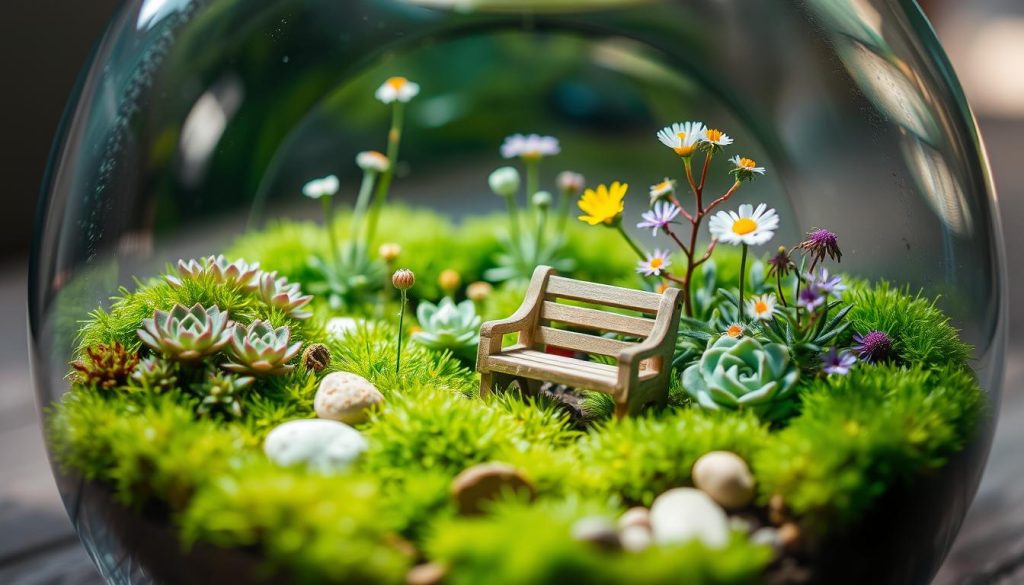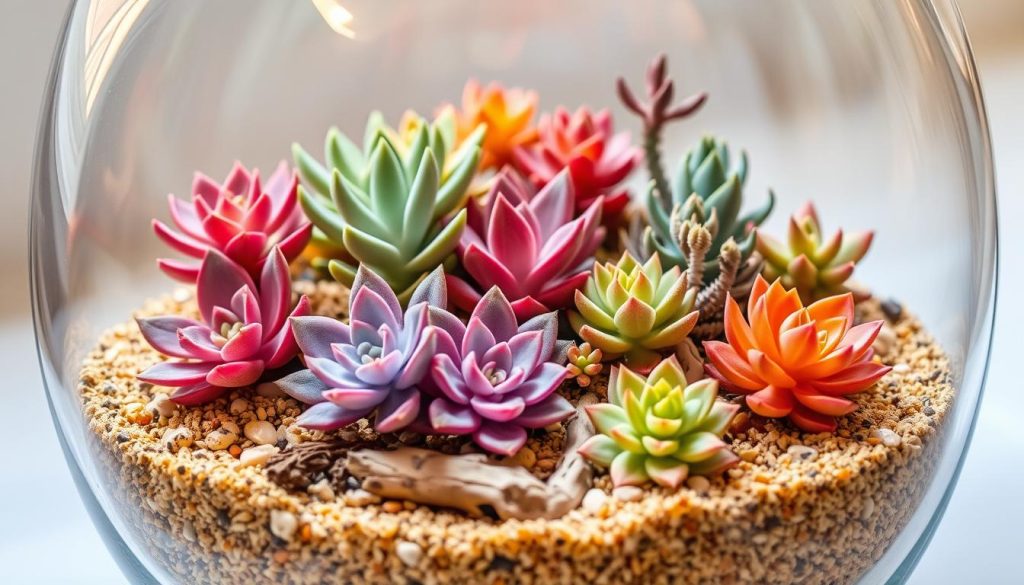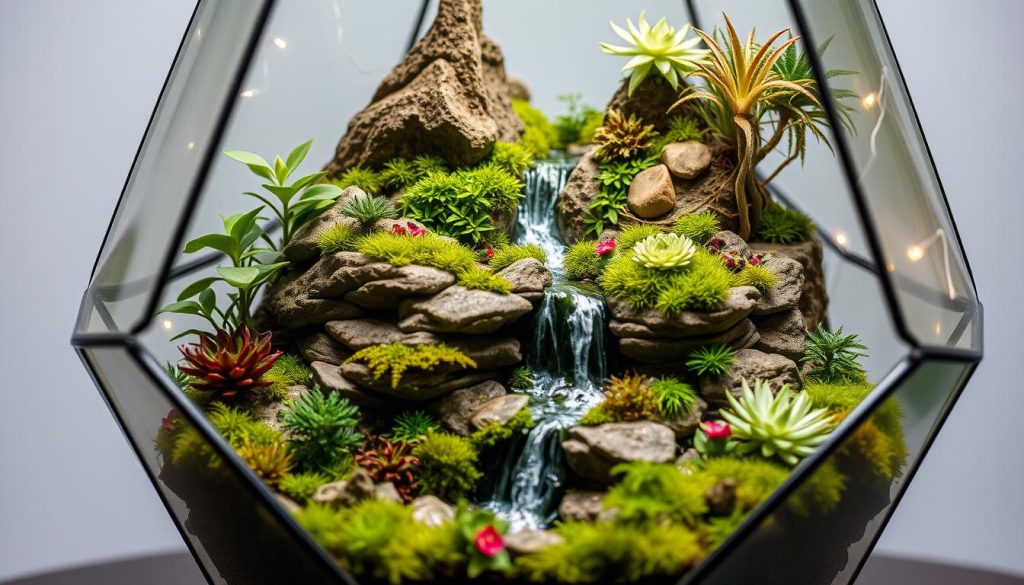Terrariums are becoming popular houseplant designs. They let you express your creativity in a fun way. These mini gardens are perfect for those who love art and plants.
With terrariums, you can create your own world inside a glass container. You can choose themes like fairy gardens or desert landscapes. This way, you can show off your personal style.

Key Takeaways
- Terrariums are versatile and allow for creative expression through various themes and plant arrangements.
- Glass containers provide the perfect medium for building these miniature indoor ecosystems.
- Incorporating decorative elements like rocks, driftwood, and small figurines can enhance the overall aesthetic.
- Terrarium designs can cater to different preferences, from tropical oasis to desert-inspired succulent arrangements.
- Terrariums are gaining popularity as low-maintenance, visually appealing houseplants.
Understanding the Basics of Terrarium Design
Terrariums bring nature indoors in a beautiful way. You can choose between open or closed systems. Knowing the basics helps you make stunning miniature gardens. Let’s explore the key elements and design tips for your own green oasis.
Types of Terrariums: Open vs. Closed Systems
There are two main types of terrariums: open and closed. Open terrariums are airy, great for plants that like dry air. Closed terrariums keep humidity high, perfect for tropical plants.
Essential Components for Building a Terrarium
Building a terrarium requires a few key things. These include:
- A glass container, like a jar or vase
- Gravel or small rocks for drainage
- Activated charcoal to keep water fresh
- A special soil mix for terrariums
- Plants that do well in terrariums
Choosing the Right Container Size and Shape
The container’s size and shape matter a lot. Big, tall containers are good for plants that climb. Small containers are perfect for detailed, small plants. Try different containers to find the right one for your design.
Best Plants for Your Indoor Terrarium
Choosing the right plants for your indoor terrarium is key. Look for plants that love humidity and grow slowly. Some top picks include nerve plants, ferns, and moss.
For a tropical look, add philodendrons, peace lilies, and alocasias. These plants love humidity and make your terrarium stand out. But, succulents like Haworthia need special care in humid terrariums to avoid rot.
- Nerve plants (Fittonia)
- Ferns
- Pixie arrowhead plants (Syngonium)
- Begonias
- Pilea plants
- Peperomia
- Creeping fig (Ficus pumila)
- Moss
For a tropical terrarium, consider including:
- Philodendrons
- Peace lilies (Spathiphyllum)
- Alocasias
Succulents, such as Haworthia and Crassula Ovata, can thrive in open terrariums, but require careful watering to prevent rot in the more humid closed environments.
Layering Techniques for Stunning Visual Effects
Take your terrarium to the next level by learning to layer. By arranging elements in a strategic way, you can add depth and texture. This turns your indoor garden into a masterpiece.
Creating Depth with Soil Gradients
Move away from flat soil. Soil gradients bring depth and interest to your terrarium. Create valleys and hills with the soil, just like in nature. This not only looks great but also helps your plants grow well.
Incorporating Different Textures
Texture makes terrariums exciting. Mix different textures like moss, driftwood, and decorative rocks. This mix of textures grabs your attention and makes the terrarium a visual treat.
Adding Decorative Elements
Make your terrarium stand out with decorative touches. Miniature stairs from pebbles add height, while big rocks or driftwood make great focal points. These details turn your terrarium into a three-dimensional wonder.
Mastering layering makes your terrariums visually stunning. They can make your indoor space feel like a lush oasis. Use depth, texture, and decorative elements to make your terrariums amazing and enhance your gardening journey.
Terrarium Designs for Different Home Styles
Terrariums are great for any home decor style. They can fit right in with modern, rustic, or minimalist looks. There’s a terrarium for every living space.
For modern terrariums, choose geometric containers and simple plant setups. Geometric shapes add a sleek, modern vibe. Pair them with succulents or air plants for a bold look.
Rustic terrarium designs use natural elements like bark and moss. They bring a cozy, earthy feel to your home. Perfect for farmhouse or industrial-chic homes, they add organic charm.
For a minimalist look, pick a few plants and a simple container. This lets the plants shine without clutter. Glass or ceramic containers fit well with minimalist decor, creating a calm, elegant space.
Every home style can be enhanced with the right terrarium. Think about the container, plants, and decorations. You can make a beautiful indoor garden that matches your style.
Creating a Tropical Paradise Theme
Bring the lush beauty of the tropics into your home with a terrarium. Focus on plants that love humidity and warmth. Ferns, philodendrons, and anthuriums will make your terrarium feel like a jungle.
Humidity-Loving Plant Selection
Choose plants that love high humidity for your terrarium. Some great picks include:
- Ferns: Delicate and elegant, ferns like the Boston fern or maidenhair fern add tropical elegance.
- Philodendrons: These vines with large, glossy leaves bring a jungle feel.
- Anthuriums: Known as the “Flamingo Flower,” these plants show off vibrant, heart-shaped blooms.
- Fittonias: Nicknamed “Nerve Plants,” these plants have intricate leaves in green, red, and pink.
- Bromeliads: These epiphytes with vivid, flower-like centers add exotic beauty.
- Air Plants: Hanging among other plants, air plants like Tillandsia look wild and natural.
Miniature Water Features
Add a miniature water feature to your terrarium for a true tropical feel. A small fountain or pool can make you feel like you’re in a jungle. The sound of water and the plants’ reflection create a calming atmosphere.
Tropical Decoration Ideas
Add whimsical touches to your terrarium for extra charm. Tiny animal figurines, like tree frogs or toucans, can bring the jungle to life. Miniature tiki huts, bamboo, or seashells can also enhance the tropical vibe. These elements will turn your terrarium into a tropical wonderland.
Desert-Inspired Succulent Arrangements
Bring the desert into your home with stunning succulent terrariums. These designs are easy to care for and show off the beauty of cacti and succulents. You can make a desert look by layering sand and gravel.
Choose a container that drains well, like a glass bowl. Use warm-toned sands and rocks for a desert feel. Place your succulents at least 5 square cm apart to avoid crowding. Water carefully, using rainwater if you can, to protect the soil from tap water.
- Choose drought-tolerant succulents like Burro’s tail, Haworthia, and Jade plant for your desert setup.
- Add aquarium rocks or small figurines to make your terrarium more interesting.
- Try a hanging planter to see your desert terrarium from a different angle.
Keeping your terrarium healthy is simple. Water sparingly, about a tablespoon per plant every few weeks. Also, replace the soil every year to keep your plants looking great. With the right care, you can have a beautiful desert oasis at home.

Miniature Woodland Terrarium Scenes
Creating a miniature woodland terrarium brings a lush, forested oasis into your home. It showcases the beauty of the forest floor. By using elements from nature, you can design a captivating woodland terrarium.
Forest Floor Elements
To create a woodland setting, start with forest floor design elements. Use small, tree-like plants like jade plants or tiny Ficus varieties as the main focus. These plants mimic the forest canopy.
Surround these plants with lush ferns and delicate moss landscapes. This brings the forest floor to life.
Creating Natural Pathways
- Use small pebbles or sand to make winding pathways in your miniature woodland scene.
- These natural elements add visual interest and mimic forest trails.
Adding Moss Features
Moss is key to creating a lush, verdant atmosphere in a woodland terrarium. Use different types of moss, like sheet moss, cushion moss, or mood moss. This adds texture and depth.
Arrange the moss to mimic natural growth patterns. This makes your terrarium feel like a real forest.
By carefully choosing elements for your woodland terrarium, you can create a captivating miniature landscape. Try different plant combinations, creative pathways, and enchanting moss features. Design your own unique woodland terrarium oasis.
Creative Container Choices
Creating a stunning terrarium doesn’t have to stick to traditional glass jars. Look into unique terrarium containers and repurposed items for a creative twist. You can find everything from gumball machines to vintage glassware to hold your mini indoor garden.
Custom-shaped glass containers are a big hit. They can turn your terrarium into a masterpiece. Choose from shapes like geometric, curved, or even hanging terrariums. The right container can really make your terrarium stand out.
- Repurpose everyday items like light bulbs, wine glasses, or mason jars for a one-of-a-kind terrarium.
- Experiment with hanging terrariums to create vertical displays and free up valuable surface space.
- Invest in custom-made glass containers to add a unique touch to your indoor garden.
The fun of unique terrarium containers is showing off your creativity and style. By using something other than a traditional glass jar, you can make your indoor garden truly yours. It becomes a reflection of your vision and personality.
Lighting Solutions for Terrarium Success
Proper lighting is key for your terrarium’s health and beauty. You can use natural sunlight or artificial LED lights. Knowing what your terrarium plants need is crucial for a balanced and stunning indoor garden.
Natural vs. Artificial Light Requirements
Terrariums in indirect natural light are perfect for many plants. But, low-light spots might need LED lights for plants. This ensures they get the light needed for photosynthesis and growth.
For natural light, avoid direct sunlight to prevent overheating and damage. Place your terrarium in partial shade or diffused light. A north- or east-facing window is ideal.
LED Integration Options
- LED strip lights: These are energy-efficient and last long. They can be placed to target your terrarium’s lighting needs.
- LED grow lights: They emit the best light spectrum for plants. Great for terrariums in low-light spots.
- Adjustable LED lighting: Choose lights with variable intensity and color. This lets you adjust the lighting to your terrarium’s needs.
By understanding your terrarium’s lighting needs and using the right LED lights, you can create a thriving indoor garden. It brings nature right into your home.
Maintenance Tips for Long-lasting Designs
Keeping your terrarium looking great is all about balance. To make sure your indoor garden stays beautiful for years, follow these key terrarium care tips:
- Watch the Moisture: It’s important to avoid too much water. For closed terrariums, use a spray bottle a few times a year. Open terrariums need good air flow to stop mold.
- Prune with Care: You’ll need to prune methods regularly to keep your terrarium plants in shape. Just trim off any dead or dying leaves to help them grow well.
- Clear Out Debris: Make sure to remove any fallen leaves, twigs, or other organic stuff right away. This stops rot and keeps pests away.
With a bit of watering techniques and careful upkeep, your terrarium will stay a lively, lasting part of your home. Enjoy the fun of caring for these tiny worlds and their beauty for many years.
Seasonal Terrarium Decorating Ideas
Terrariums are charming living art pieces that can be easily adapted to different seasons and holidays. By incorporating seasonal plant selections and themed decorations, you can transform your indoor garden. This creates a delightful display that reflects the changing moods of the year.
For the fall season, consider adding miniature pumpkins, autumn-colored foliage, and earthy elements like pinecones or dried branches to your terrarium. This creates a cozy, harvest-inspired look that perfectly complements the changing leaves outside.
- Incorporate plants with rich hues of red, orange, and yellow to capture the autumn palette.
- Experiment with seasonal moss or dried flowers to add texture and visual interest.
- Arrange small gourds or acorns around the base of your terrarium for a natural touch.
When winter arrives, transform your terrarium into a serene winter wonderland. Use white sand or crushed quartz to mimic the appearance of snow, and include miniature evergreen trees or branches to evoke the feeling of a snowy forest.
- Select plants with silvery-gray or pale foliage to complement the wintry theme.
- Incorporate small decorative elements like tiny snowflakes or glass ornaments.
- Consider adding a touch of sparkle with glittering accents or LED lights.
As spring arrives, embrace the season’s vibrant energy by incorporating blooming plants and pastel colors into your terrarium. Incorporate small spring flowers, such as violets or primroses, and complement them with lush, green foliage.
For a summery twist, you can create a beach-inspired terrarium with sand, shells, and tropical plants, or a lush, jungle-themed design featuring larger foliage and miniature water features.
By exploring seasonal terrarium decorating ideas, you can keep your indoor garden constantly evolving and engaging. This brings the beauty of nature into your home throughout the year.
Advanced Terrariums Designs for Enthusiasts
For those who love terrariums, there’s a whole new world to explore. You can make your indoor gardens even more special. Use complex designs, rare plants, and new landscaping tricks to make your terrariums stand out.
Multi-Level Arrangements
Advanced terrariums often have levels stacked on top of each other. This creates a beautiful, tall landscape. It lets you grow many different plants in one small space.
Specialized Plant Communities
Creating special plant groups in terrariums is exciting. You might make a terrarium for carnivorous plants or one filled with rare succulents. It takes a lot of knowledge to care for these plants and make their homes right.
Using special landscaping tricks adds to the beauty. Mini waterfalls, mist systems, and detailed designs make your terrarium a unique, humid home for plants.

Whether you’re new to terrariums or have been doing it for years, there’s always more to learn. With creativity and the right skills, you can make amazing terrariums. They will amaze and inspire everyone who sees them.
Troubleshooting Common Design Issues
Creating a thriving terrarium is a fun experience, but it comes with challenges. You might face a few common problems that need quick fixes. Let’s look at some effective solutions for these terrarium troubles.
Condensation Buildup
Too much condensation in a closed terrarium can cause mold and harm plants. To fix this, try opening the lid more often or add a small fan. Also, make sure you’re not watering too much and that the soil drains well.
Mold and Fungus
If mold or fungus shows up in your terrarium, act fast. Remove any bad plant parts and clean the inside with a weak bleach solution. Improve air flow and water less to stop it from coming back. If it keeps happening, you might need to change the soil.
Wilting or Yellowing Plants
Wilting or yellow leaves mean there’s a problem with light, water, or soil. Check if your plants fit well in the terrarium. Adjust how often you water and think about moving it if the light is wrong.
Overgrowth and Crowding
As plants grow, they might take up too much space. Trim back any big plants or move some to bigger containers. It’s important to keep the right balance of plants and space for your terrarium to stay healthy and look good.
By tackling these common terrarium problems, plant health issues, and design fixes, your indoor garden will keep thriving. It will also continue to make your home a happier place.
Conclusion
Terrariums are a creative way to bring nature indoors. They are easy to care for and fit well in any home. You can make them your own, showing off your style and love for plants.
Whether you like lush green spaces or dry desert scenes, terrariums are perfect. They let you grow plants and enjoy their calming effect, even in small homes. This guide will help you create a beautiful terrarium that adds wonder to your space.
Start your terrarium journey and let your creativity shine. Turn your home into a peaceful, natural haven. With the right plants and care, your terrarium will be a beautiful part of your home for years.